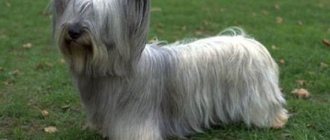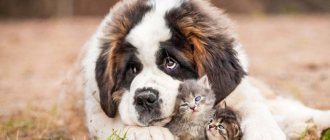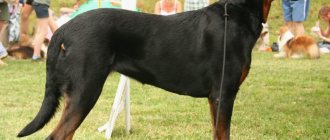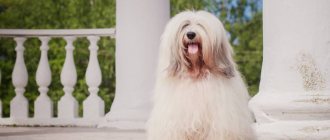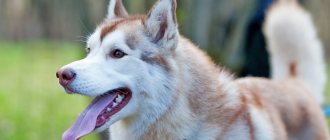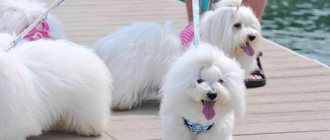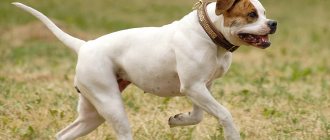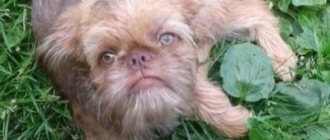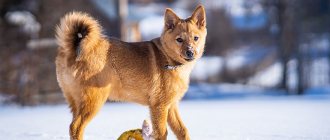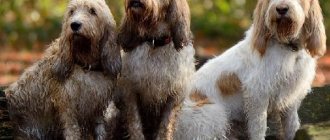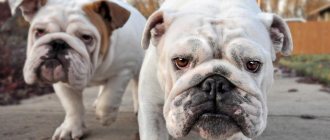History of the origin of the breed
The homeland of the Norfolk Terrier is the eastern part of Great Britain, the county of Norfolk. They were first bred at the end of the 19th century for burrow hunting. Initially, Norwich Terriers were also included in this group, but since 1964 the dogs have been divided into different breeds of the same group. Today, Norfolk dogs are rare, despite several centuries of active breeding, they have not lost their hunting skills, playfulness and ability to learn.
Photo: wikimedia.org
Description of the breed
The appearance of the Norfolk Terrier has remained virtually unchanged since the 19th century. The animal is distinguished by its compact size and angular body shape, typical for the entire group. As an adult, the dog grows up to 5.5 kg; females are usually slightly smaller. The body is tight, with a short and flat top. Hind thighs are well developed. The tail is small in size and always erect. The limbs are short, muscular, and the paws have dense pads. Due to this size, fast running is impossible; the dog moves by actively mincing its paws and loves to jump.
A recognizable feature is its medium-length, coarse coat. The head is quite wide and rounded, the muzzle is wedge-shaped. Dark eyes are intelligent and wary.
Colors
The coarse wool has not undergone any changes in the process of many years of breeding. Due to its structure, dirt does not stick to it well, and water is repelled. Main colors of the breed:
- various shades of red;
- gray (grayish, or grizzly);
- wheat;
- black and tan, or grizzly.
White spots are allowed only on the chest, but their presence is undesirable. Puppies are darker, the hair on the nose and tail becomes lighter as they grow older. The breed has a short but thick beard, which develops equally in males and females. Regular trimming is required; if this is not done, the dog will become overgrown.
Standard
Basic standards for the breed were published in 1979 and have not changed since then. Criteria for evaluating dogs at exhibitions:
- Frame. The body of the Norfolk Terrier is small and powerful. There should be a straight line at the top that goes into the arched hips. In puppies, the imbalance of proportions manifests itself to a weak degree.
- Limbs. The front legs are short and straight. The hind ones are more developed, there are well-formed muscles. Be sure to have thick pads.
- Head. The skull is wide and rounded, more powerful between the ears. There is a clear transition from the muzzle to the forehead. The muzzle is wedge-shaped, strong. The teeth should be large; healthy individuals have a perfect scissor bite. The eyes are deep-set and usually dark brown or black. The look is smart and insightful. Ears are drooping.
- Wool. Only hard, wiry wool is allowed. It should fit snugly to the body; on the neck and shoulders its structure is denser and rougher. Haircuts with scissors or clippers are prohibited.
- Tail. The tail is of medium length, docked by European standards. Planted approximately at top level. The tail is thick at the base and should stand as straight as possible.
In the ring, not only the exterior of a particular representative of the breed is assessed, but also the ability to breed. To do this, examine the jaws and testicles of male dogs.
Character and behavioral characteristics
The Norfolk Terrier is an active and lively dog. Considered one of the best small breeds for burrow hunting. Even show animals retain their skills - during a walk they can chase birds and small animals. They adapt to apartments, but love long walks. They get along with people, demonstrate a balanced psyche and love for children. Due to the pronounced hunting instinct, it is not recommended to have small pets (guinea pigs, mice and rats) for living together.
The Norfolk Terrier can be a good companion and watchman. When hunting, they are able to work alone or in a pack, they quickly learn to drive small animals out of holes, protect the farm from attacks by foxes and ferrets.
Pros and cons of the Norfolk Terrier breed
Advantages:
- The Norfolk Terrier is highly trainable and loves physical and mental exercise.
- The fur of this representative of the fauna practically does not shed.
- The dog is not prone to whims and caprices, and is very obedient.
- The Norfolk is a hardy and active animal that does not seek to be the center of attention.
Flaws:
- The Norfolk Terrier loves to eat and can easily become fat without control.
- Representatives of the breed are very cunning and can fool their owner.
- Norfolk absolutely cannot stand loneliness and needs constant communication.
Education and training
Like other terriers, education and training are required from the first months of life. If you don't take care of your pet, its activity and temperament can develop into aggression towards other animals. This is especially true for males who try to dominate with larger dogs. Dogs of this breed are susceptible to small animals and have no aggression towards people.
You cannot show aggression towards an animal - the Norfolk Terrier is sensitive to such an attitude towards itself, touchy. As part of training a dog, first of all, you need to teach the ability to hear the owner, the command “near” and “come”. Thanks to their developed intelligence, they are able to learn more complex commands and tricks. They can be stubborn. Conduct classes in a playful way, reinforcing the completion of tasks with treats.
Walks
Until old age, Norfolk Terriers love active and long walks in the fresh air. Every day you need to spend at least 2 hours a day with your pet, letting him run out and throw out the accumulated energy. To maintain muscle tone and endurance, be sure to play with your dog. Representatives of this breed love to run after a ball or disc and swim. Tug of war is permissible only after the formation of molars (from 8-10 months) in order to avoid bite pathologies.
Photo: maxpixel.net
Character
Norflock Terriers are energetic, cheerful and fearless pets. They tend to dominate, so they need to be raised from early childhood. Norflocks love children and are always ready to take an active part in all children's fun. These terriers get along well with other pets, but they perceive small animals as prey. Norflock is capable of being jealous of his master towards other charges if he considers that he is not receiving enough attention. These terriers don't like to bark. But in case of danger, they will warn the owner of the impending threat with their loud barking. Norflocks are active dogs that need physical and intellectual exercise. If these pets don't get enough activity, they become bored, bark for no reason, and become stubborn.
Diseases
Norfolk Terriers do not have typical hereditary diseases. In rare cases, epilepsy is observed; if this disease is detected, the dog must be removed from breeding. To ensure your pet is always healthy and active, you need to undergo an annual veterinary examination. It is recommended to have your teeth cleaned at least once every two years.
Vaccinations for Norfolk Terriers
The dog develops immunity by 4 months. The first vaccination is recommended from 2 months, then after 21-28 days, depending on the pet’s well-being. Before this period, it is forbidden to walk to avoid contracting dangerous infections. Modern vaccines, for example, Nobivac, are complex - they protect against a number of diseases (distemper, leptospirosis, infectious hepatitis, parvovirus enteritis and others). Rabies vaccinations should be given no earlier than 3 months. After the procedures, check for the doctor’s stamp and sticker in your passport.
Photo: wikimedia.org
What to feed a Norfolk Terrier
The Miniature Norfolk Terrier does not need a lot of food, but loves to eat. It is better not to feed him from your hands - he may inadvertently bite his fingers.
diet : it should contain meat, cereals, fruits and vegetables, as well as dairy products. Adult dogs should eat 2 times a day, and puppies - 4-5. Read more about puppy nutrition...
Mating
During the first heat, it is not recommended to breed a dog, since the body has not yet fully formed. The optimal age is 2 years; it is advisable to plan this process on the 10-15th day of estrus. If possible, you can take a special test to determine the readiness of the eggs for fertilization. A pair of Norfolk Terriers should be selected based on color, weight and height. They should be combined as much as possible, ideally the male should be smaller than the female (to avoid caesarean section due to the large size of the puppies).
It is better to conduct introductions on the territory of the bitch in order to reduce the dog’s anxiety. During mating, you must not separate the dogs or frighten them or make loud noises - this can lead to serious injuries, for example, rupture of the genitals. Control mating is carried out after 24-48 hours.
Pregnancy
The gestation period of Norfolk Terriers lasts 51-56 days. Too early or late birth can lead not only to the death of the litter, but also to serious problems with the health of the bitch. During this time, you need to strengthen your diet and also give your dog vitamin supplements. The number of litters reaches up to 4 puppies; during the first pregnancy, their number is usually less.
To avoid various problems during childbirth, it is better to seek the help of a qualified veterinarian. Before whelping, the bitch should be given a mild laxative to cleanse the intestines and carefully monitor the animal’s condition. Norfolk Terriers have good maternal instincts; there are no problems with raising offspring.
https://www.youtube.com/watch?v=WFbc-e_CF-Y
Health and life expectancy
Norfolk Terriers can boast of good health, they are hardy and unpretentious dogs, and rarely get sick. Given good housing conditions, timely vaccination and other preventive measures, they live on average 13-15 years. But it should be noted that the breed has a number of hereditary diseases:
- Upper respiratory tract syndrome (various pathologies of the development of the respiratory organs that lead to respiratory failure);
- Congenital and acquired problems with the cardiovascular system;
- Epilepsy;
- Portosystemic shunt in the liver;
- Tumor diseases in adulthood;
- Tendency to skin diseases, in particular demodicosis;
- Pancreatitis;
- Dislocation of the kneecap;
- Urolithiasis disease;
- Monarchism and cryptorchidism;
- Eye diseases (corneal ulcer, cataract);
- Allergies;
- Untimely loss of baby teeth, which leads to polydentia.
Norfolks, as a rule, are low-fertile, the number of puppies in a litter is 1-4. By the time of birth, babies become quite large, and they also have a large head, so childbirth is difficult and often ends in a caesarean section.
Care
Norfolk Terrier dogs do well in apartments and private homes. Keeping it outside or in an enclosure is not recommended due to its short coat without undercoat. The pet must have its own place, which must be clean and dry. It is recommended to get a small bed, otherwise the dog will get used to sleeping in the bed. Breed care specifics:
- Frequent bathing and washing the coat is not recommended; trimming should be done twice a year by hand or with a special brush;
- Check the condition of the ears and teeth weekly and clean them if necessary;
- inspect claws and cut them at least once a month. If you plan to use the dog for hunting, it is advisable to amputate the dewclaws, if present, while still a puppy.
For the winter, it is advisable to leave longer hair - this allows the dog to keep warm and prevents it from freezing during long walks. Paws need to be washed after going outside.
Selection of accessories
To walk your dog, you should get a collar with an address tag, a tape measure or a leash. It is not recommended to use a harness - it reduces the quality of contact during movement. For feeding, it is best to purchase metal bowls with a growth regulator, adding it as your pet develops. If you plan to trim the hair yourself, you will need 1-2 trimmers with different tooth sizes. Clothing is not required for this breed.
Photo: pixnio.com
Feeding
Natural or dry food is used to feed the Norfolk Terrier. To maintain muscle mass and activity, at least 65% protein in the diet is required, which is difficult to achieve when cooking on your own. It is better to use only beef, rabbit or chicken as meat. A mixture of cereals, such as buckwheat and pearl barley, can be a source of carbohydrates. When choosing a brand of food, you should pay attention to the size of the granules - they should be small. Older dogs and puppies need additional vitamin and mineral supplements.
Nicknames for Norfolk Terrier
You should think about a name for your pet in advance. It is important to take into account the requirements for the breed (the common first letter of the name for the entire litter), the characteristics of the dog and your own preferences.
For a Norfolk boy, courageous nicknames are more suitable, at the same time reflecting the activity and cheerfulness of the breed, for example, Alt, Rem, Gray, Chris, Jay, etc.
For a Norfolk girl - gentle and soft, talking about fidelity, affection and beauty, such as Jessie, Erica, Wendy, Lucy, Taffy, etc. In order for the dog to better remember his nickname, it should contain no more than 3 syllables.
Tips for choosing puppies
When choosing a pet, pay attention to the health and appearance of the parents, and request all the necessary certificates. It is best to purchase the most active and intelligent puppy from the litter. It is important to carefully examine the condition of the limbs, body and check the coat. It should be uniform and hard. When examining the paws, pay attention to mobility and movement while running. Immediately cull animals with dislocated (twisted) limbs.
https://www.youtube.com/watch?v=NDnuvkqdFOw
Owner reviews
Arina F. “We got a Norfolk three years ago. At first he was a problem dog - he was poorly trained, it took a long time to learn to go to the toilet on the street. He did a lot of mischief at home, but now we have dealt with his character. The mouse is a real member of the family.”
Slava A. “It’s impossible not to fall in love with the Norfolk Terrier. This is a smart, beautiful and very active dog. I take my friend with me to the forest for a run in the morning. Among the minuses, I can only mention the craving for hunting. We had a hard time weaning him from chasing birds.”
Purpose and character of the Norfolk Terrier
The Norfolk Terrier is a burrowing hunting dog and an indispensable companion . It is distinguished by a passionate desire to hunt rats, mice and other small creatures such as rabbits, ferrets, weasels and even foxes.
Norfolk Terriers are excellent at both solitary and pack hunting: the courage, instant reaction and passion of these dogs does not leave burrowing animals any chance to survive. Living in a private house with a large household, the Norfolk reliably protects all domestic animals from uninvited guests - predators.
The Norfolk Terrier has a cheerful, energetic and determined disposition , but at the same time is very sensitive in relationships with people and pets. The dog is obedient, flexible, easily finds a common language with people and animals, calm and attentive.
A balanced and responsible character eliminates mood swings.
Jumping, curious and very intelligent representatives of the breed actively participate in the life of the family. The Norfolk is an excellent companion for a small child, a loyal protector and friend who will never offend.
An energetic and fearless pet easily adapts to the lifestyle of its owner. A heightened sense of self-esteem and a predictable disposition - this is all about the Norfolk. At the same time, the dog perfectly protects itself, its owner, family and home from all kinds of enemies. It is noteworthy that with good upbringing, representatives of the breed are not characterized by aggression, pampering and spoiling.
Similar breeds
All small terriers are similar because they have a common genetic base. They differ in size, color and other external characteristics. A closely related breed is the Norwich Terrier.
Norwich Terrier
Outwardly, they are completely identical to the Norfolk Terrier. The only difference is the erect ears. They have similar colors, sizes and characters. However, some owners note a more balanced disposition and friendliness.
Photo
Photo: wikimedia.org
Photo: wikimedia.org
Photo: pixnio.com
Briefly about the main thing
- The Norfolk Terrier is a small hunting breed. It was bred in England in the 19th century, and today it has completely preserved its exterior and temperament characteristics.
- The dog gets along well with people. May be aggressive towards small animals and birds.
- Caring for the breed is quite difficult. Regular trimming (pinching of fur) is required, as well as training from puppyhood.
- The breed is only suitable for keeping at home. Does not tolerate severe frosts well due to the lack of undercoat.
The Norfolk Terrier is a rare and interesting breed of dog. Tell us in the comments about your experience keeping these miniature hunters.
Did you like the article? Share it with your friends on social media. networks. This will help them get useful information and support our project.
How to choose a puppy
The Norfolk Terrier, which is not so easy to buy in Russia, is more popular in Europe and America.
But still, if you are lucky enough to find Norfolks, remember the hanging ears - this is their main feature.
The Norfolk Terrier, whose puppies conquer anyone, must correspond to the following description:
- strong, squat body;
- ears adjacent to the cheeks;
- thick, coarse wool;
- small smart eyes;
- tail docked at half length;
- color between black and tan and wheaten.
Experts advise choosing the strongest and most stately puppy from the pack; such a puppy will certainly grow up healthy and proudly bear the title of Norfolk Terrier.
Prices for these babies range from $1,200 to $2,800. The breed is quite rare; moreover, no more than four babies are born in one litter.
Training and education of the Norfolk should begin from a very early age. Then there is a chance to make a perfectly educated and trained dog out of the dog.
Experts advise choosing the strongest and most stately puppy from the pack, such a one will certainly grow up healthy and proudly bear the title of Norfolk Terrier
